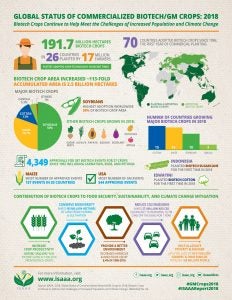New data show that biotech crop plantings have increased about 113-fold since 1996, with an accumulated area of 2.5 billion hectares, pointing to biotechnology being the fastest-adopted crop technology in the world. In all, 70 countries adopted biotech crops through cultivation and importation in 2018, making it the 23rd consecutive year of biotech crop adoption.
This was part of an in-depth annual report called the Global Status of Commercialized Biotech/GM Crops in 2018, put out by the International Service for the Acquisition of Agri-biotech Applications. The full report is available for purchase on the ISAAA’s website.
First and foremost, it must be recognized that the ISAAA has a deep interest in seeing crop technology succeed, so the report does talk about how “undeniably necessary” biotechnology is to our future with food security and climate change. But it also does a lot of good in drawing out critical factual data so that we have a fuller picture of the role of biotech crops, which are developed with improved traits such as increased yield, more resistance to pests, and improved nutrition, among others.
Among the key data findings:
The top 5 countries with the largest area of biotech crops planted (USA, Brazil, Argentina, Canada, and India) collectively occupied 91 percent of the global biotech crop area. Adoption rates of major crops are at levels close to 100%, indicating that farmers favor this crop technology over the conventional varieties.
- Biotech soybeans reached the highest adoption worldwide, covering 50 percent of the global biotech crop area.
- The area of biotech crops with stacked traits continued to increase and occupied 42 percent of the global biotech area.
- Farmers in 10 Latin American countries planted 79.4 million hectares of biotech crops.
- In Europe, Spain and Portugal continued to adopt biotech maize to control European corn borer.
- More area planted to biotech crops for farmer and consumer needs included potatoes with non-bruising, non-browning, reduced acrylamide and late blight resistant traits; non-browning apples; insect resistant eggplant; and low lignin alfalfa, among others .
- New crops and trait combinations in farmer fields include insect resistant and drought tolerant sugarcane; high oleic acid canola and safflower.
- There were various food, feed, and processing approvals for Golden Rice, Bt rice, herbicide tolerant cotton, low gossypol cotton, among others.

In recent years, biotech crops have expanded beyond the big four (maize, soybeans, cotton, and canola) to give more choices for many of the world’s consumers and food producers, according to the report. These biotech crops include alfalfa, sugar beets, papaya, squash, eggplant, potatoes, and apples, all of which are already in the market. Two generations of Innate potatoes with non-bruising, non-browning, reduced acrylamide, and late blight resistant traits as well as non-browning Arctic apples were already planted in the U.S. Brazil planted the first insect resistant sugarcane; Indonesia, the first drought tolerant sugarcane; and Australia planted the first high oleic acid safflower for R&D and seed propagation.
“By increasing yields and reducing losses, [biotech] contributed to food availability for more families. By enabling farmers to improve their processes and join the modern supply chain, it improved physical access to food. Through raising farmer and rural incomes, it improved economic access to food. Through rigorous standards of food safety and hygiene programs, it contributed to better food utilization,” said Dr. Paul S. Teng, ISAAA Board Chair. “While agricultural biotechnology is not the only key in enhancing global food security, it is an important scientific tool in the multi-disciplinary toolkit.”


